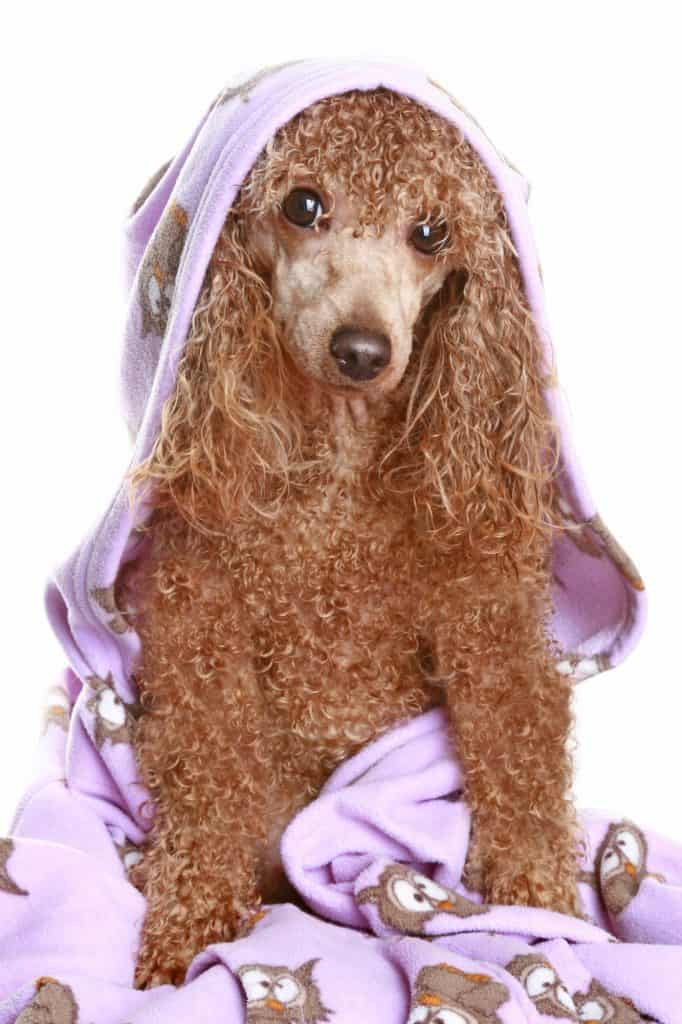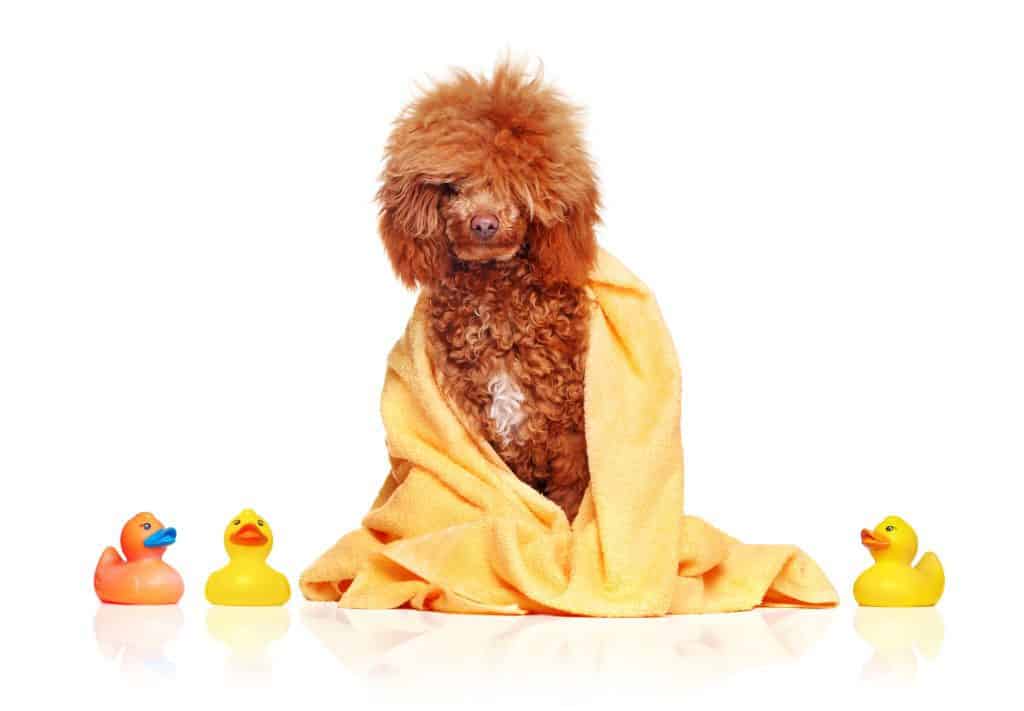Overview
Bathing your poodle is one of the most important things that you can do for them aside from grooming, training and feeding them the best dog food.
Bathing your poodle in preparation for a show is a much more meticulous process than what outlined here in this article.
With that being said you will also want to take care that you don’t bathe your poodle too often as it can cause drying and cracking of their skin. You will need to find a balance between bathing and grooming to help their coat stay beautiful, soft and free of knots.
Let’s take a deeper dive into the steps you’ll want to take to give our pup an awesome bath.
When to bathe a poodle puppy
You’ve done tons of research on breeders, decided on the color poodle you want, and now all of the questions start flowing into your mind. When is it ok to bathe a poodle puppy?
Not to worry, we will go over that and more in the sections below.
Poodle puppies are little baby furballs and we want to make sure we take great care of them. The recommended age to begin washing your poodle for the first time is around 3 months of age. Thereafter, you’ll want to bathe them about once per month. Any more than that and you run the risk of drying out their skin and stripping it of natural oils.
Keeping your poodle clean in between baths
Washing your puppy too often is certainly something to consider given the negative effects on their skin. But what can you do in between baths to make sure your furry pup doesn’t smell or stay dirty? Here are a few tips that can help keep your puppy clean.
- Wet sponge/cloth: Simply wet the sponge or cloth and rinse it well. Gently scrub or rub the problem areas, rinsing the sponge as often as needed. Towel dry or use a dryer if needed.
- Dry Foam – there are plenty of professional products on the market that allow you to dry-bathe your poodle. You can find these items in a pet shop or even online. Simply apply the foam to your poodle and then brush it throughout the dog’s coat. Once all traces of the product are gone you’re done!
- Wet wipes- Baby wipes or similar dog-specific products will work about the same. Simply use these wipes to clean specific areas of the coat that are dirty and then brush thoroughly afterward.
How often should I bathe my poodle?
This is a common question when it comes to poodles. You should wash your poodle about every 21 to 35 days or so. Staying within this timeframe ensures that their skin has more than enough time to regain natural oils in the skin as well as for the skin to regenerate.
Washing your poodle more often than that can disrupt the skin’s natural oils. Combined with using shampoos that strip the hair and skin this can lead to other skin problems if overwashing occurs over a longer period of time. The glands in your dog’s skin called sebaceous glands are what is responsible for replenishing and revitalizing the skin with natural oil secretions.
What type of products to use to bathe poodles?
There are many options available to poodle owners when it comes to products. Many shampoos and conditioners are formulated for all dogs and coat types. Other’s are formulated just for poodles.
Overall, you’ll find that these bathing products range widely in price from budget shampoos and conditioners to more expensive and high-quality products. The choice is yours but just remember that quality will have a big impact on your poodle’s coat. A midrange bathing product is usually the best option.
If your poodle has white or light-colored hair be aware that there are some shampoos available that will help to brighten the coat. In addition, there are some home remedies or products you can use to remove tear stains from your poodle’s eyes.
How to bathe your poodle (step by step)

Step 1 – Brush, Comb, and Detangle
First things first! Before you even reach over to turn the knob on the tub or wash station there are a few things that you’ll want to take care of first. Believe it or not, what you do before your dog has a drop of hair on them is just as, if not more important than the bath itself.
Regularly brushing and grooming your dog will make this process a lot easier. You’ll want to first ensure that all of your poodle’s tangles and knots are gently removed from the coat. Ensure that you thoroughly brush and comb the coat. You’ll know you’re done when you can brush and comb your pup’s coat from the root to tip without a single kink.
One of the things that people always ask about poodles is “Do poodles shed”? While it’s true that poodles don’t shed their coat is comprised of hair. Like the hairs on your head, they all have a life cycle. Over time, older strands will run their course and be replaced by new hair. Some of these hairs find their way into the corner of your living room. The rest will remain trapped within the coat, awaiting the gentle stroke of a brush or comb to release it.
The primary goal of grooming the coat before a bath is to ensure that any tangles and knots already present in the coat are not fortified or made worse with water. Wet tangles and mats are not only a nightmare to remove for you but they can also be painful for your dog.
Step 2 – Preparing Bathing Area
Once you have completely combed and brushed out your poodle and they are free of mats and tangles it’s time to prepare the bathing area. But first, a quick potty break for your poodle! Given the length of time it takes to bathe and dry a poodle’s coat you’ll thank yourself later.
Gathering all of your products and tools and ensure they are within reach is very important. You won’t want to have to step away searching for items in the middle of bathing your dog.
Some of the basic bathing tools and products you’ll want close at hand include:
- A rubber strainer insert for drain ( to prevent clogs)
- A handheld water hose or sprayer (or a medium-sized bucket for wetting and rinsing)
- Rubber gloves (optional)
- Waterproof apron
- Shampoo brush
- Washcloth (for removing eye boogers around the eyes
- Shampoo (use products designed to boost color or brighten light/white coats if necessary)
- Conditioner or creme rinse
- Several large bath towels
Step 3 – Shampooing
Now for the fun part! Getting your dog nice and clean! To start, it’s worth noting that you don’t ever want to wash your poodle with a shampoo formulated for humans. It’s important that the shampoo you use be formulated for the Ph for canines. Not adhering to this can result in an unhealthy coat and dry irritated skin. We definitely don’t want that, so be sure that you select a good quality shampoo.
Over time, some poodle coats can become stained and color distribution can become uneven. To combat this some owners opt for a color enhancing canine shampoo that naturally intensifies the color of the poodle’s coat. For white and light-colored poodles it will make a very noticeable difference in the brightness of the coat and greatly reduce any yellowing or gray tints that may have settled in. In darker colored poodles they do a great job of removing any orange or red tipping and giving the coat a more even colored coat.
Once you have selected a good quality shampoo then you can start to bathe your dog. Before starting you may want to put on your waterproof apron and rubber gloves (for those with sensitive skin).
From there you’ll want to place your poodle in the tub or washing station and use warm water to thoroughly wet the coat. Using a water hose or spray attachment is highly recommended. However, if you only have a medium-sized bucket that will suffice.
You’ll want to work your way down the coat and avoid wetting the head or ears. Ensure that you have fully saturated the coat with water before using shampoo. Using a spray nozzle/hose is a better option because you can place it close to skin and roots. This will help to loosen and wash away any debris or dirt near the base of the hair.
Apply shampoo and methodically work into the coat. You may use a shampoo brush to help work into the coat. Wash the head and ears last being very careful not to get soap in your poodle’s eyes or inside the ear canal. It is recommended that you thoroughly wash the dog twice.
Step 4 – Rinsing the coat
This is probably the part of the process your poodle will enjoy the most.
When rinsing your dog it is important that you wash away all traces of the shampoo. Leaving behind shampoo can lead to skin irritation, difficulty scissoring, and a dull-looking coat.
When rinsing you will always want to start with the head being careful to shield their eyes from suds and also ensuring that you don’t get any water into the ear canal.
It is highly recommended to use a spray nozzle/hose for rinsing. After rinsing the head you will want to work your way down the neck, back and towards the tail. Ensure you rinse under the stomach, down and under the legs including the feet, genital area, and rear. You’ll want to continue rinsing until the water is clear and no more shampoo is visible.
Step 5 – Applying conditioner or cream rinse
With the coat nice and clean you will want to move on to applying a conditioner or cream rinse. Conditioners or cream rinses are designed to moisturize the hair and skin, restore elasticity, retain color and smooth the hair cuticle. While shampoo does a fantastic job cleaning your poodle it can also cause tangles within the coat.
Conditioning the coat is a very important step that you will not want to skip.
After thoroughly working the conditioner or cream rinse into the poodle’s coat be sure to rinse away all traces of the conditioner.
Step 6 – Drying your Poodle
Once you’ve finished rinsing out the coat, you will want to dry your poodle. Cover them with a large towel and work it over their body so that it absorbs most of the water.
After that, you will want to grab a blow dryer and work it section by section over the coat until it is completely dry. Use a brush during this process and completely brush out the coat and you’re all set!



